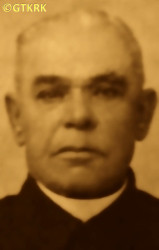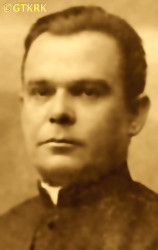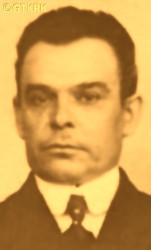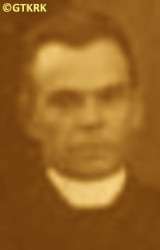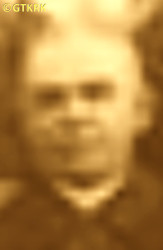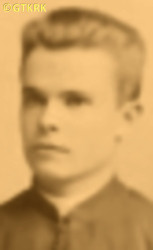Roman Catholic
St Sigismund parish
05-507 Słomczyn
85 Wiślana Str.
Konstancin deanery
Warsaw archdiocese, Poland
full list:
displayClick to display full list

searchClick to search full list by categories
wyświetlKliknij by wyświetlić pełną listę po polsku

szukajKliknij by przeszukać listę wg kategorii po polsku

Martyrology of the clergy — Poland
XX century (1914 – 1989)
personal data
religious status
Servant of God
surname
MEKIELITA
surname
versions/aliases
MEKELITA
forename(s)
Peter (pl. Piotr)
forename(s)
versions/aliases
Peter (pl. Petro)

function
eparchial priest
creed
Ukrainian Greek Catholic GCmore on
en.wikipedia.org
[access: 2013.05.19]
diocese / province
Przemyśl GC eparchymore on
pl.wikipedia.org
[access: 2013.05.19]
honorary titles
canonmore on
en.wikipedia.org
[access: 2014.11.14]
nationality
Ukrainian
date and place
of death
30.08.1947

Lvivtoday: Lviv urban hrom., Lviv rai., Lviv obl., Ukraine
more on
en.wikipedia.org
[access: 2022.01.16]
alt. dates and places
of death
30.09.1947
details of death
In 1914 during World War I left his parish managing to escape from then–victorious Russians and moved to Vienna.
After battle of Gorlice in 05.1915 when German and Austrians defeated Russians and pushed them back far into the east returned to his parish.
After German and Russian invasion of Poland in 09.1939 and start of the World War II, after German attack on 22.06.1941 of their erstwhile ally, Russians, and start of German occupation welcomed German occupiers: „Brothers and sisters! From now on we are Ukrainian nation!”.
But then interceded for persecuted Jews and Communists.
Following German defeat and start of another Russian occupation in 1944 — living then in Lviv — was being persuaded (during interrogations at Russian genocidal NKVD organisations' station in Drohobych) to leave Greek Catholic unite church and join Russian Orthodox.
Refused.
Arrested by the Russians on 21.06.1945 and jailed in Drohobych prison (at the same time two other local deans were arrested by the same NKVD Drohobych, including Fr Michael Żuk).
Accused, among other, that „during temporary German occupation […] were members of the quotas due to German army commission and participated in determining taxes imposed upon their fellow citizens.
[…] In 10.1942 were called to the Basilian Fathers' monastery in Drohobych […], where an officer of the Gestapo recruited them as German agents, and they signed a promise to conduct fascist propaganda, directed against the Russian authorities.
In 1943 [‐] they spoke publically at a meeting organized by Ukrainian nationalists during which young people were urged to join [Ukrainian 14th SS‐Grenadiers' Division known as] SS‐Galizien”, of „Motherhood betrayal and cooperation with fascists”.
On 29.12.1945 sentenced by a Russian NKVD summary kangaroo court of Drohobych region to 10 years of slave labour in Russian concentration camps Gulag.
On 23.09.1946, after 9 months in Drohobych prison where was incessantly and without success being persuaded to apostize and joing Russian Orthodox church, transferred to Lviv transit prison — transit camp No. 25 set up by the Russians in 1944 in the former Jewish ghetto part of the city as a temporary prison for inmates heading to Gulag concentration camps in Russia — where perished.
cause of death
extermination
perpetrators
Russians
sites and events
GulagClick to display the description, Lviv (transit prison no 25)Click to display the description, Drohobych (prisons)Click to display the description, Ribbentrop‐MolotovClick to display the description, Pius XI's encyclicalsClick to display the description
date and place
of birth
13.06.1868

Butynytoday: Velyki Mosty urban hrom., Sheptytskyi rai., Lviv obl., Ukraine
more on
uk.wikipedia.org
[access: 2023.03.02]
parents
MEKIELITA Theodore
🞲 ?, ? — 🕆 ?, ?

ZALEWSKA Thecla
🞲 ?, ? — 🕆 ?, ?
presbyter (holy orders)
ordination
09.12.1894

Przemyśltoday: Przemyśl city pov., Subcarpathia voiv., Poland
more on
en.wikipedia.org
[access: 2021.04.01]
positions held
1921 – 1945
dean — Boryslavtoday: Boryslav urban hrom., Drohobych rai., Lviv obl., Ukraine
more on
en.wikipedia.org
[access: 2020.11.01] GC deanery
1919 – 1945
parish priest — Stebnyktoday: Drohobych urban hrom., Drohobych rai., Lviv obl., Ukraine
more on
en.wikipedia.org
[access: 2022.01.16] ⋄ Nativity of the Blessed Virgin Mary GC parish ⋄ Boryslavtoday: Boryslav urban hrom., Drohobych rai., Lviv obl., Ukraine
more on
en.wikipedia.org
[access: 2020.11.01] GC deanery — also: till c. 1939, inspector of religious instruction in elementary schools in Boryslav deanary Drohobych county
1910 – 1919
dean — Sanoktoday: Sanok urban gm., Sanok pov., Subcarpathia voiv., Poland
more on
en.wikipedia.org
[access: 2021.10.09] GC deanery
1899 – 1919
parish priest — Prusiek‐Sanoczekparish name
today: Sanok gm., Sanok pov., Subcarpathia voiv., Poland
more on
en.wikipedia.org
[access: 2022.01.16] ⋄ Intercession of the Blessed Virgin Mary GC parish ⋄ Sanoktoday: Sanok urban gm., Sanok pov., Subcarpathia voiv., Poland
more on
en.wikipedia.org
[access: 2021.10.09] GC deanery
1898 – 1899
administrator — Prusiek‐Sanoczekparish name
today: Sanok gm., Sanok pov., Subcarpathia voiv., Poland
more on
en.wikipedia.org
[access: 2022.01.16] ⋄ Intercession of the Blessed Virgin Mary GC parish ⋄ Sanoktoday: Sanok urban gm., Sanok pov., Subcarpathia voiv., Poland
more on
en.wikipedia.org
[access: 2021.10.09] GC deanery
1894 – 1898
vicar — Prusiek‐Sanoczekparish name
today: Sanok gm., Sanok pov., Subcarpathia voiv., Poland
more on
en.wikipedia.org
[access: 2022.01.16] ⋄ Intercession of the Blessed Virgin Mary GC parish ⋄ Sanoktoday: Sanok urban gm., Sanok pov., Subcarpathia voiv., Poland
more on
en.wikipedia.org
[access: 2021.10.09] GC deanery
1893 – 1894
student — Przemyśltoday: Przemyśl city pov., Subcarpathia voiv., Poland
more on
en.wikipedia.org
[access: 2021.04.01] ⋄ philosophy and theology, Greek Catholic Theological Seminary
1890 – 1893
student — Lvivtoday: Lviv urban hrom., Lviv rai., Lviv obl., Ukraine
more on
en.wikipedia.org
[access: 2022.01.16] ⋄ philosophy and theology, Greek Catholic Theological Seminary
1890 – 1894
student — Lvivtoday: Lviv urban hrom., Lviv rai., Lviv obl., Ukraine
more on
en.wikipedia.org
[access: 2022.01.16] ⋄ philosophy and theology, Department of Theology, John Casimir University [i.e. clandestine John Casimir University (1941‐1944) / Ivan Franko University (1940‐1941) / John Casimir University (1919‐1939) / Franciscan University (1817‐1918)]
married — seven children
others related
in death
ŻUKClick to display biography Michael
sites and events
descriptions
Gulag: The acronym Gulag comes from the Rus. Главное управление исправительно‐трудовых лагерей и колоний (Eng. Main Board of Correctional Labor Camps). The network of Russian concentration camps for slave labor was formally established by the decision of the highest Russian authorities on 27.06.1929. Control was taken over by the OGPU, the predecessor of the genocidal NKVD (from 1934) and the MGB (from 1946). Individual gulags (camps) were often established in remote, sparsely populated areas, where industrial or transport facilities important for the Russian state were built. They were modeled on the first „great construction of communism”, the White Sea‐Baltic Canal (1931‐1932), and Naftali Frenkel, of Jewish origin, is considered the creator of the system of using forced slave labor within the Gulag. He went down in history as the author of the principle „We have to squeeze everything out of the prisoner in the first three months — then nothing is there for us”. He was to be the creator, according to Alexander Solzhenitsyn, of the so‐called „Boiler system”, i.e. the dependence of food rations on working out a certain percentage of the norm. The term ZEK — prisoner — i.e. Rus. заключенный‐каналоармец (Eng. canal soldier) — was coined in the ITL BelBaltLag managed by him, and was adopted to mean a prisoner in Russian slave labor camps. Up to 12 mln prisoners were held in Gulag camps at one time, i.e. c. 5% of Russia's population. In his book „The Gulag Archipelago”, Solzhenitsyn estimated that c. 60 mln people were killed in the Gulag until 1956. Formally dissolved on 20.01.1960. (more on: en.wikipedia.orgClick to attempt to display webpage
[access: 2024.04.08])
Lviv (transit prison no 25): Founded in the autumn of 1945 by Russian murderous MVD (successor of genocidal NKVD) in the former Lviv Jewish ghetto. One of the largest of its kind in Russia. 21 barracks, hospital and office bulding were constructed there. Prisoners had to wait from week to a year for transport to one of concentration camps Gulag. Closed down in 1955. (more on: www.territoryterror.org.uaClick to attempt to display webpage
[access: 2020.04.04])
Drohobych (prisons): Before the outbreak of the World War II in 09.1939 a criminal prison functioned at Drohobych Truskawiecka Str. where c. 1,200‐1,500 inmates were held. After the start in 09.1939 of the first Russian occupation a new jail run by Russian NKVD genocidal organization was opened at Striyska Str. (by regional NKVD headquarters). There in 06.1941, after German attack of their erstwhile ally, Russians, NKVD perpetrated a genocidal massacre of prisoners. After German defeat and start in 1944 of another Russian occupation NKVD returned to the same buildings and again opened their jail, where hundreds and thousands of people suspected of not supporting Russia were held and interrogated. The jail was closed in 1959. The prison at Truskawiecka Str. however remained open throughout the World War II, both during Russian and German occupations, stayed open after the end of military hostilities and operates till today. (more on: btx.home.plClick to attempt to display webpage
[access: 2020.04.04])
Ribbentrop‐Molotov: Genocidal Russian‐German alliance pact between Russian leader Joseph Stalin and German leader Adolf Hitler signed on 23.08.1939 in Moscow by respective foreign ministers, Mr. Vyacheslav Molotov for Russia and Joachim von Ribbentrop for Germany. The pact sanctioned and was the direct cause of joint Russian and German invasion of Poland and the outbreak of the World War II in 09.1939. In a political sense, the pact was an attempt to restore the status quo ante before 1914, with one exception, namely the „commercial” exchange of the so‐called „Kingdom of Poland”, which in 1914 was part of the Russian Empire, fore Eastern Galicia (today's western Ukraine), in 1914 belonging to the Austro‐Hungarian Empire. Galicia, including Lviv, was to be taken over by the Russians, the „Kingdom of Poland” — under the name of the General Governorate — Germany. The resultant „war was one of the greatest calamities and dramas of humanity in history, for two atheistic and anti‐Christian ideologies — national and international socialism — rejected God and His fifth Decalogue commandment: Thou shall not kill!” (Abp Stanislav Gądecki, 01.09.2019). The decisions taken — backed up by the betrayal of the formal allies of Poland, France and Germany, which on 12.09.1939, at a joint conference in Abbeville, decided not to provide aid to attacked Poland and not to take military action against Germany (a clear breach of treaty obligations with Poland) — were on 28.09.1939 slightly altered and made more precise when a treaty on „German‐Russian boundaries and friendship” was agreed by the same murderous signatories. One of its findings was establishment of spheres of influence in Central and Eastern Europe and in consequence IV partition of Poland. In one of its secret annexes agreed, that: „the Signatories will not tolerate on its respective territories any Polish propaganda that affects the territory of the other Side. On their respective territories they will suppress all such propaganda and inform each other of the measures taken to accomplish it”. The agreements resulted in a series of meeting between two genocidal organization representing both sides — German Gestapo and Russian NKVD when coordination of efforts to exterminate Polish intelligentsia and Polish leading classes (in Germany called «Intelligenzaktion», in Russia took the form of Katyń massacres) where discussed. Resulted in deaths of hundreds of thousands of Polish intelligentsia, including thousands of priests presented here, and tens of millions of ordinary people,. The results of this Russian‐German pact lasted till 1989 and are still in evidence even today. (more on: en.wikipedia.orgClick to attempt to display webpage
[access: 2015.09.30])
Pius XI's encyclicals: Facing the creation of two totalitarian systems in Europe, which seemed to compete with each other, though there were more similarities than contradictions between them, Pope Pius XI issued in 03.1937 (within 5 days) two encyclicals. In the „Mit brennender Sorge” (Eng. „With Burning Concern”) published on 14.03.1938, condemned the national socialism prevailing in Germany. The Pope wrote: „Whoever, following the old Germanic‐pre‐Christian beliefs, puts various impersonal fate in the place of a personal God, denies the wisdom of God and Providence […], whoever exalts earthly values: race or nation, or state, or state system, representatives of state power or other fundamental values of human society, […] and makes them the highest standard of all values, including religious ones, and idolizes them, this one […] is far from true faith in God and from a worldview corresponding to such faith”. On 19.03.1937, published „Divini Redemptoris” (Eng. „Divine Redeemer”), in which criticized Russian communism, dialectical materialism and the class struggle theory. The Pope wrote: „Communism deprives man of freedom, and therefore the spiritual basis of all life norms. It deprives the human person of all his dignity and any moral support with which he could resist the onslaught of blind passions […] This is the new gospel that Bolshevik and godless communism preaches as a message of salvation and redemption of humanity”… Pius XI demanded that the established human law be subjected to the natural law of God , recommended the implementation of the ideal of a Christian state and society, and called on Catholics to resist. Two years later, National Socialist Germany and Communist Russia came together and started World War II. (more on: www.vatican.vaClick to attempt to display webpage
[access: 2023.05.28], www.vatican.vaClick to attempt to display webpage
[access: 2023.05.28])
sources
personal:
newsaints.faithweb.comClick to attempt to display webpage
[access: 2022.12.13], uk.wikipedia.orgClick to attempt to display webpage
[access: 2019.04.16], www.sde.org.uaClick to attempt to display webpage
[access: 2020.01.06], magazine.lds.lviv.uaClick to attempt to display webpage
[access: 2014.03.21]
bibliographical:
„Clergy of Przemyśl Eparchy and Apostolic Exarchate of Lemkivshchyna”, Bogdan Prach, Ukrainian Catholic University Publishing House, Lviv 2015
original images:
risu.org.uaClick to attempt to display webpage
[access: 2019.04.16], uk.wikipedia.orgClick to attempt to display webpage
[access: 2019.04.16], www.christusimperat.orgClick to attempt to display webpage
[access: 2019.04.16], www.christusimperat.orgClick to attempt to display webpage
[access: 2019.04.16], missiopc.blogspot.comClick to attempt to display webpage
[access: 2014.09.21]
LETTER to CUSTODIAN/ADMINISTRATOR
If you have an Email client on your communicator/computer — such as Mozilla Thunderbird, Windows Mail or Microsoft Outlook, described at WikipediaPatrz:
en.wikipedia.org, among others — try the link below, please:
LETTER to CUSTODIAN/ADMINISTRATORClick and try to call your own Email client
If however you do not run such a client or the above link is not active please send an email to the Custodian/Administrator using your account — in your customary email/correspondence engine — at the following address:

giving the following as the subject:
MARTYROLOGY: MEKIELITA Peter
To return to the biography press below:
 Click to return to biography
Click to return to biography








